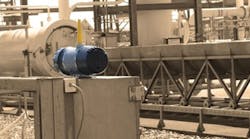Check Out Montague's Google+ profile.
Finding tiny, significant or potentially hazardous gas sources is an essential safety capability in many process applications, but just sensing is no good unless those signals and data can be delivered to people and systems that need them.To help advance efforts to provide better protection, ExxonMobil Upstream Research Co. is investigating the use of wireless components to get gas indications where they need to go. Bin Xu, an instrumentation control engineer at ExxonMobil, recently sought to demonstrate and verify the feasibility and reliability of a battery-operated, ISA100 wireless gas detection system with a redundant gateway at Exxon's lab in Houston.
"We wanted to examine wireless because it's faster to install and costs less to deploy compared to a hard-wired solution," said Xu. "Also, this cost benefit could be particularly attractive for a brownfield project."
Xu presented "Wireless Gas Detection Test for Safety Applications" today at the 2014 Yokogawa Users Group Conference and Exhibition in Houston.
"We wanted to examine wireless because it's faster to install and costs less to deploy compared to a hardwired solution," said Bin Xu, instrumentation control engineer, ExxonMobil. "This cost benefit could be particularly attractive for a brownfield project."
"Overall, we installed three GS01 gas detectors from Norway-based GasSecure with a redundant YFGW 410 wireless gateway system and YFGW 510 transmitter from Yokogawa at an ExxonMobil site," explained Xu. "The wireless protocol we used is ISA100.11a, which uses a Modbus interface into the control system. Initially, we collected wireless data without feeding it into our safety system. Also, all three instruments were installed right next to existing wired gas detectors for comparison, and sensor and network performances were tracked as well." ISA100 just became a global IEC standard last week.Xu added that the wireless-enabled gas detection system was configured all the way to a Modbus tag and was plug-and-play for ExxonMobil's site. The test system's gateway and instruments were pre-tested by GasSecure and were shipped from Norway directly to ExxonMobil. "The trick is to complete commissioning as simply as possible, so we asked the vendor to configure these components all the way to the gateway and make sure this was done before shipping to us," said Xu. "We asked each supplier to do the same. We provided parameters, IP addresses and other needed details, they did the configuration, and then we could just do the interface. This made our wireless system easier to set up and made it simple for us to pull diagnostic information into our other systems."
In addition to the savings, Xu added that using wireless for gas detection is also a very flexible method and even allowed him to establish it as a redundant system. "You just have to make sure that your device doesn't go beyond the capabilities of the gateway," said Xu. "This system could also be used in a SIL2 application. We asked for and used Profisafe networking and were able to get this project up and running in just six weeks, which was a lot quicker than we expected. We want to promote wireless for safety in oil and gas applications, and what we really need to make it happen is standards like ISA100 and common guidelines and experiences—the more prescriptive, the better."






